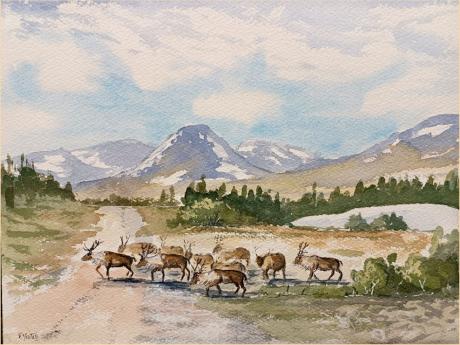" P Yates"
Unframed
When the railway opened in 1882, it was the beginning of what would become Sweden's most popular winter resort. And for the past 80 years, the Swedish royal family celebrates every Easter in their cottage in Storlien. If you are looking for true unexploited wilderness, but still family friendly and easy to access by car, train or flight - Storlien is the place for you. Located on the mountain itself, you literary only have to walk (or ski) a few hundred meters before you have past the tree line where nothing can block the breathtaking views of the vast Swedish mountain. Most likely you will see herds of reindeer, rare species of birds and flowers.Due to the surrounding geography, Storlien holds one of Sweden's top positions in snow depth. In winter time, a depth of 200 cm is not rare.
Storlien is a village and ski resort located in Åre municipality in Jämtland, Sweden, two kilometres from the Swedish-Norwegian border. The primary bases of the settlement are tourism and outdoor life – alpine skiing, snowmobiling, cross-country skiing, hunting, fishing and hiking. During the 2000s, retail sales to customers from Norway become important, and most of the tourists in Storlien are Norwegians. The Swedish royal family has a house in Storlien, where they usually celebrate Easter and the New Year. There was also previously a sanitarium. Storlien was formerly the centre of winter activities for Skidfrämjandet, now Friluftsfrämjandet, an organisation that promotes outdoor leisure, and played a major role in developing downhill skiing in Sweden.
Storlien has, among other services, a hotel called Storliens högfjällshotell ('Storlien Mountain Lodge') and a holiday village called Fjäll-lien. A large part of the village is owned by the Lars Nilsson estate, a real estate agent. The hotel was formerly the largest in the country. In 2011 Ulrich John, a Stockholm real-estate investor, bought it, the lifts and "a few thousand hectares of mountain", but he sold the hotel in 2013.
Until the beginning of the 19th century, Storlien was mostly used by Norwegians for hunting, fishing and summer pasturing. The village was first settled in 1844, and late in the 19th century began its development into a tourist centre. The Central Line opened in 1882, and the physician Ernst Westerlund opened a summer practice there in the same year. A few years later, two hotels opened. Thanks to its easily accessible high mountain terrain and railway station, Storlien soon became a centre for the activities of the outdoor activities organisation Skidfrämjandet. In 1924, on the initiative of female instructors, they held a four-day course in "modern ski technique" at Storlien in collaboration with the Swedish Ski Delegation and the Swedish Tourist Association. The instructor was Gunnar Dyhlén, who taught different ways to turn the skis, and the course is thus also considered the starting point for organised Alpine skiing in Sweden. At New Year's in 1931, the first slalom course in Sweden, Möllers Backe, was spontaneously cleared on the mountain slopes of Skurdalshöjden. In 1933 Prince Gustaf Adolf and Princess Sibylla received as a wedding gift from Skidfrämjandet a holiday cabin which is still owned by the royal family.
The Swedish ski pioneer Olle Rimfors visited the Austrian ans Swiss Alps and returned with lots practical knowledge of alpine skiing. On his return in 1934 he established Slalombacken at Storlien; this was the first purpose-built slalom slope in Sweden after the old slalom course at Östeberget in Östersund. In 1935, under Rimfors' leadership, Friluftsfrämjandet held there the first international slalom competition in Jämtland under International Ski Federation rules; it was the second in Sweden if an event in Riksgränsen at Pentecost 1934, in which an American tourist took part, is included. Sweden's first slalom club, Skidfrämjandets slalomklubb, was also organised in Storlien, with the entire country as its region.
During World War II Storlien was used by the military and was a restricted destination. In 1940, top-secret military negotiations between Sweden and Nazi Germany were held there in a railway carriage. In 1942 the first ski lift opened in Storlien, the second one to be built in Sweden. In 1958 the hotel was expanded to a capacity of 550 guests; it was the largest in the country and in the mid-1960s employed 274 people.
Between 1972 and 1995, the industrialist Matts Carlgren was majority shareholder of the hotel, which went bankrupt in 1998. The following year Lars Nilsson bought the hotel and the surrounding land, around 3,000 hectares (7,400 acres), for 37 million kronor. In July 2011, Stockholm real-estate investor Ulrich John bought the hotel and a substantial part of the mountain. The hotel did not open for the 2012–13 season,[6] but a new owner has held it open during the 2013–14 season.
Storlien has been popular among visitors from the Norwegian county of Trøndelag, who go there for border shopping, mountain cabins, and skiing. After traditionally only having a small grocery store in the village centre, the shopping selection sharply increased in the 2010s, with a Coop Extra opening in 2011, and Eurocash in 2014, culminating in the shopping centre Fjellhandel opening in 2020.
Storlien Station, in the centre of the village and the highest station in Sweden .The ski area at Storlien has nine lifts and 23 slopes. However, the vertical drop is a comparatively low 191 m (627 ft), and consequently the slopes are quite short. There are three children's areas with platter lifts and easy slopes, and night skiing under lights every Friday at Slalombacken.

